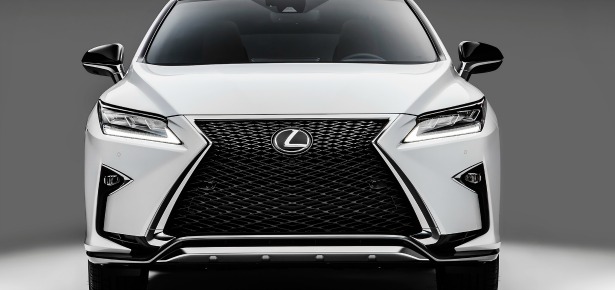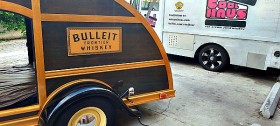Posts tagged 2016 Lexus RX 350 review

2016 Lexus RX350 F Sport Review

What do you do when you’re already on top?
Do you answer your critics or double down on what got you there?
That’s the question facing Lexus these days. Every few years since 1998 Lexus has launched a new RX in the American market. Each version is lauded as the pinnacle of comfort and practicality and gently dismissed as lacking performance and excitement.
The RX then spends another year at the top of the Luxury Crossover SUV segment, often selling 100,000 units and beating the market by a wide margin.
This year, more than ever before, the RX looked to answer the criticism with a renewed emphasis on driver experience and performance.
The Look
The new RX has ditched the egg shaped profile of its past, leaving previous models looking a bit tame by comparison. The redesign lets us read the tea leaves into the next 5 years of design from the Toyota Motor Corp. They have embraced sharp angles and masculine lines and gone all in on their now signature spindle grille. This younger, more masculine look will undoubtedly move down the line until finally landing on the Corolla. Notes like L shaped LED daytime running lamps give a brightness to the front end of the car. The vehicle uses long, pronounced lines and the appearance of a floating roof to make it look as though more than 5″ has been added to last years model.
The Drive
Even more than the visual redesign, this is where Lexus tried to address their critics the most. Easily the biggest improvement in the F Sport trim level is the addition of the Adaptive Variable Suspension. This allows you to adjust the ride to “S+” mode, which lowers the vehicle by nearly an inch and tightens the shocks. This stiffens the ride, allowing for a better driver experience with tighter turning and less body roll. The winding roads of Marin County and the Pacific Coast Highway proved a fine testing ground for the 25 extra horsepower and tightened suspension. For a vehicle with a curb weight of almost 4,400 pounds it performed well in and out of turns and provided enough acceleration to pass slower traffic with ease. Though far from a sports car, the improvements to handling and acceleration are noticeable and worthy of the F Sport badge.
Inside
Classy. Pronounced stitching and premium materials give the interior a very posh appearance. The optional 12.3″ navigation system (8″ standard) perches atop the center of the dash and communicates all of the entertainment, climate control and navigation information clearly. The Remote Touch makes a slightly less clunky reappearance. The software now predicts what you’re trying to interact with to varying degrees of success. As you get used to the tendencies it gets easier but the industry wide struggle for intuitive controls continues another year. The 2016 edition builds on the success of its previous incarnations with a comfortable and luxurious ride up front with just enough space in back for average sized adults. The driver centered cabin helps the operator and vehicle communicate safely and comfortably.
Features
It’s not often I get into a car and get surprised by a new bell or whistle. The empirical nature of auto design gives away the surprise a little at a time every year, so by the time a feature is in place it’s already been hinted at for years.
Not so with the 360 degree view shown when you put the RX in reverse. Four cameras are used, one in the grille, one under each side mirror and the backup camera in the rear. The resulting image is stitched together by all four, giving you a helicopter style view in tight spaces. Think the original Grand Theft Auto overhead view. I called it my validation cam. Get into a tight spot, engage the overhead camera and see how great (or terrible) of a parking job you did. The usefulness of the technology really shines when reversing out of parking spaces into busy streets or lots. The Rear Cross Traffic Alert warns of any bogeys coming in from the side, the overhead camera gives a 360 degree view and the parking assist shows the line that the car will continue on if the wheels are set in that direction. For a car with a big hood and a long body these features are invaluable for visibility. Absolutely loved them and used them constantly.
Then there’s All Speed Dynamic Radar Cruise Control. Alphabet soup, I know. That rather wordy feature is new to the RX and can be summed up easily. It is quite simply the future of driving. Set the maximum speed you wish the car to attain and let your foot off the gas. The vehicle will maintain a safe follow distance up to that speed without any input from the driver. On a long road trip this feature is an absolute game changer. Set the control to 73 and rest your legs. The car will sense when the vehicle in front slows down and adjust speed safely until the desired follow distance is achieved.
This feature works with normal traffic and unexpected stops alike. If necessary it is capable of bringing the car to a complete stop.
Anyone who has driven the 5 Freeway through central California just salivated a little at the idea. I felt fresh as a daisy and never strayed too far over the speed limit. As an enthusiast I can’t say I looked forward to the driverless car but this feature got me thinking.
For Lexus, and every automaker, design and engineering is a balancing act. Go too far to the new and they lose their roots. Too much performance usually means too much comfort, too much comfort makes for a pedestrian ride. A vehicle that sits squarely in the middle will be accused of being vanilla and lacking identity. This years Lexus RX is a great redesign in that respect. They manage to push back against their detractors without losing much of what a hundred thousand buyers a year are looking for.
Now, about those self driving cars…
2016 Lexus RX 350 F Sport
3.5L V6 Engine with 295 HP
8 speed automatic transmission
0-60 6.9 seconds
19-26 mpg
$55,645 – $59,325

Feb 3rd




















